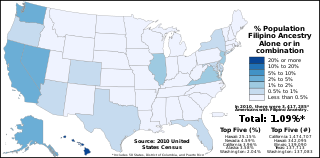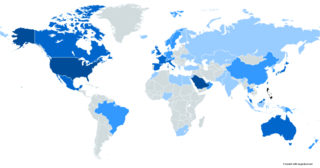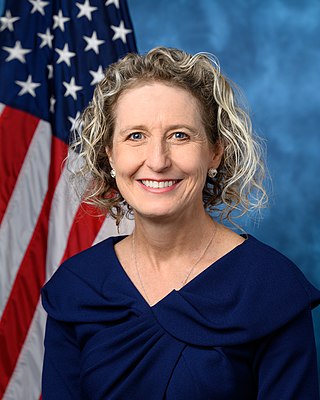
Norfolk is an independent city in Virginia, United States. As of the 2020 census, Norfolk had a population of 238,005, making it the third-most populous city in Virginia after neighboring Virginia Beach and Chesapeake, and the 95th-most populous city in the nation. Norfolk holds a strategic position as the historical, urban, financial, and cultural center of the Hampton Roads region, which has more than 1.8 million inhabitants and is the 37th-largest metropolitan area in the U.S., with ten cities.

Virginia Beach, officially the City of Virginia Beach, is the most populous city in the Commonwealth of Virginia in the United States. The population was 459,470 at the 2020 census. Located on the southeastern coast of Virginia, it is the sixth-most populous city in the Mid-Atlantic and the 43rd-most populous city in the U.S. Located on the Atlantic Ocean at the mouth of the Chesapeake Bay, Virginia Beach is a principal city in the Hampton Roads metropolitan area which has more than 1.8 million inhabitants and is the 37th-largest metropolitan area in the U.S.

Hampton is an independent city in the Commonwealth of Virginia in the United States. The population was 137,148 as of the 2020 census, making it the seventh-most populous city in Virginia. Hampton is included in the Hampton Roads metropolitan area, the 37th-largest in the United States, with a total population of 1,799,674 in 2020. This area, known as "America's First Region", also includes the independent cities of Chesapeake, Virginia Beach, Newport News, Norfolk, Portsmouth, and Suffolk, as well as other smaller cities, counties, and towns of Hampton Roads.

Chesapeake is an independent city in Virginia, United States. At the 2020 census, the population was 249,422, making it the second-most populous city in Virginia, the tenth largest in the Mid-Atlantic, and the 89th-most populous city in the United States.

Hampton Roads is the name of a body of water in the United States that serves as a wide channel for the James, Nansemond, and Elizabeth rivers between Old Point Comfort and Sewell's Point near where the Chesapeake Bay flows into the Atlantic Ocean. It also gave its name to the surrounding metropolitan region located in the southeastern Virginia and northeastern North Carolina portions of the Tidewater Region.

Old Dominion University (ODU) is a public research university in Norfolk, Virginia. Established in 1930 as the Norfolk Division of the College of William and Mary, an extension school of the College of William & Mary for people with fewer financial assets, members of the military, and non-traditional students in Norfolk-Virginia Beach area of the Hampton Roads region. The university has since expanded into a residential college for traditional students and is one of the largest universities in Virginia with an enrollment of 23,494 students for the 2023 academic year. The university also enrolls over 600 international students from 99 countries. Its main campus covers 250 acres (1.0 km2) straddling the city neighborhoods of Larchmont, Highland Park, and Lambert's Point, approximately five miles (8.0 km) north of Downtown Norfolk along the Elizabeth River.

Filipino Americans are Americans of Filipino ancestry. Filipinos in North America were first documented in the 16th century and other small settlements beginning in the 18th century. Mass migration did not begin until after the end of the Spanish–American War at the end of the 19th century, when the Philippines was ceded from Spain to the United States in the Treaty of Paris.

South Hampton Roads is a region located in the extreme southeastern portion of Virginia's Tidewater region in the United States with a total population of 1,177,742 as of 2020. It is part of the Virginia Beach-Norfolk-Newport News, VA-NC MSA, which itself has a population of 1,780,059 as of 2020.

Hampton Roads Transit (HRT), incorporated on October 1, 1999, began through the voluntary merger of PENTRAN on the Virginia Peninsula and TRT in South Hampton Roads and currently serves over 22 million annual passengers within its 369-square-mile (960 km2) service area around Hampton Roads. The purpose of the HRT is to provide reliable and efficient transportation service and facilities to the Hampton Roads community. In 2023, the system had a ridership of 7,263,900, or about 29,700 per weekday as of the second quarter of 2024.

An overseas Filipino is a person of full or partial Filipino origin who trace their ancestry back to the Philippines but are living and working outside of the country. They get jobs in countries, and they move to live in countries that they get jobs in. This term generally applies to both people of Filipino ancestry and citizens abroad. As of 2019, there were over 15 million Filipinos overseas.
The Filipino American National Historical Society (FANHS) is a nonprofit organization that documents Filipino American history.
Since Norfolk serves as the commercial and cultural center for the geographical region of Hampton Roads, it can be difficult to separate the economic characteristics of Norfolk, from that of the region as a whole. The waterways which almost completely surround the Hampton Roads region also play an important part in the local economy. As a strategic location at the mouth of the Chesapeake Bay, its protected deep water channels serve as major arteries for the import and export of goods from across the Mid-Atlantic, Mid-West, and international destinations, as well as being the location of the world's largest naval base.
Since the 1890s, the United States has periodically relied upon Filipino nurses to help meet the needs of the healthcare system. This collaboration has been a significant contributor to the migration of Filipinos to the U.S., as Filipino citizens increasingly had personal connections in America. Since 1960, more than 150,000 nurses have migrated from the Philippines.
Filipino Austrians are Austrians of full or partial Filipino descent and are part of the so-called Overseas Filipinos. When excluding Afghan, Iraqi and Syrian refugees, Filipinos make up the fourth largest group of Asians within Austria, behind Iranian, Chinese and Indian people and form the largest Southeast-Asian community in the country. The majority of them live in Vienna, the capital of Austria.
Nursing in the Philippines is provided by professionally trained nurses, who also provide a quarter of the world's overseas nurses. Every year, some 20,000 nurses work in other countries. Nurses in the Philippines are licensed by the Professional Regulatory Commission. The advance of nursing in the Philippines as a career was pioneered by a culture of care that is intrinsic in the Filipino people. This began before Spanish colonization.

The history of Filipino Americans begins in the 16th century when Filipinos first arrived in what is now the United States. The first Filipinos came to what is now the United States due to the Philippines being part of New Spain. Until the 19th century, the Philippines continued to be geographically isolated from the rest of New Spain in the Americas but maintained regular communication across the Pacific Ocean via the Manila galleon. Filipino seamen in the Americas settled in Louisiana, and Alta California, beginning in the 18th century. By the 19th century, Filipinos were living in the United States, fighting in the Battle of New Orleans and the American Civil War, with the first Filipino becoming a naturalized citizen of the United States before its end. In the final years of the 19th century, the United States went to war with Spain, ultimately annexing the Philippine Islands from Spain. Due to this, the history of the Philippines merged with that of the United States, beginning with the three-year-long Philippine–American War (1899–1902), which resulted in the defeat of the First Philippine Republic, and the attempted Americanization of the Philippines.

The demographics of Filipino Americans describe a heterogeneous group of people in the United States who trace their ancestry to the Philippines. As of the 2020 Census, there were 4.4 million Filipino Americans, including Multiracial Americans who were part Filipino living in the US. Filipino Americans constitute the third-largest population of Asian Americans, and the largest population of Overseas Filipinos.

In the New York metropolitan area, Filipinos constitute one of the largest diasporas in the Western Hemisphere. By 2014 Census estimates, the New York City-Northern New Jersey-Long Island, NY-NJ-CT-PA Combined Statistical Area was home to 262,375 Filipino Americans, 221,612 (84.5%) of them uniracial Filipinos.

Jennifer Ann Kiggans is an American politician and nurse practitioner serving as the U.S. representative for Virginia's 2nd congressional district. A Republican, Kiggans is a former United States Navy helicopter pilot. She defeated incumbent Elaine Luria in the 2022 election.














